davidsonian.news
College Democrats and Republicans hash out their pre-debate thoughts.

davidsonian.news
College Democrats and Republicans hash out their pre-debate thoughts.
For a Better Davidson.
October 16, 2024
ACLAIRE KELLY ‘25 (SHE/HER) CO-EDITOR-IN-CHIEF
ccording to a quick search on Zillow, the average Davidson, North Carolina home value is $655,450, a number that has gone up nearly 6% in the past year. In 2016, this number was $357,798. In an ever-changing real estate market in a college town that prides itself on its student-faculty relationships, how do faculty at Davidson navigate these expenses?
Davidson has two housing programs that are geared toward faculty: a college rental housing program and a home purchase program called a land leasing program.
Director of Facilities Business Leslie Urban helps coordinate this process.
“Typically, I meet with departments [and] with faculty when they’re interviewing for positions, and so I sit down with candidates and talk to them about the program,” she described. “I tell them I cannot guarantee them housing because it’s a supply/demand operation, and it could be [that] I don’t have enough units, or [...] I don’t have the units that fit their needs.”
Urban also emphasized the limits to which faculty are allowed to stay in Davidson rental housing. “There’s a limit of seven years as to how long you could live in rental housing that’s built around the tenure process, so a tenure track faculty member could come to Davidson, move into a rental house, and [...] when they have tenure, [...] they’d have another year to figure out where they wanted to live.”
The land leasing program works differently. “The way that works is we own ninety-six houses in the town and when someone [...] in one of those houses moves [...] I buy the house back from them [...] because the college owns the land that the house sits on.” Yet, from time to time, exceptions can be made. Former Charles A. Dana Professor of English Emerita Dr. Cynthia Lewis, who retired in 2023, lives in college housing close to campus. She could often be seen riding her bike across the street toward Chambers, where she would bring Shakespeare’s works to life with her students. “When I first came in, everything was much smaller [...] The college really wanted faculty to live in town
Annalee StuardiDrumm ‘27 reflects on the role of the Pledge of Allegiance.
Coach Abell breaks the Davidson football record for wins.
The Yowl analyzes the lifestyle of Little Freak.
because it was a tradition,” Dr. Lewis stated. Dr. Lewis, who had a personal agreement with a former president of the college to remain in her housing post-retirement, gave insight into how she thinks the process has changed.
“Now, I think a lot of people commute from Huntersville and Cornelius and probably Mooresville [...] where the housing is maybe slightly more affordable or maybe more available,” she said. “So that dream of having the faculty [near] campus sort of shifted. That’s the ethos that I came into anyway.”
Professor of English Dr. Randy Ingram ‘87 also echoed how times have changed from when he attended Davidson as a student to now. “I first lived in college housing on Main Street, [...] a few hundred yards to the Student Health Center, and it was great,” he stated. “Obviously, I was so close to campus. That was a huge benefit, and that meant that students could come over, [...] but that was part of the traditional dynamic when I was a student, we all went to professors’ houses.”
The school has a methodical approach to distributing professor housing, so it is not always as simple as solely trying to create the community dynamic that Davidson has cultivated in the past.
“I have a [rental housing] waitlist of seventy people,” Urban said in early July. “The way the rental program works is from January through July 1st, priority is always for the faculty, so [...] [the faculty member seeking housing] could go to my waiting list. [...]
If I have units vacate in January, February, and March, I’m holding them open for the incoming faculty that will come in July.”
Vice President for Finance, Administration, and CFO Ann McCorvey oversees Urban’s department and believes that the administration does what it can for professors. “We certainly have relocation programs and all of that, but it is really the employee’s responsibility to figure out where they’re going to live,” McCorvey stated.
“That said, Davidson is very generous I think, as compared to other colleges.”
While the college does their best to assist faculty needs, there are still many that feel apprehensive about the process. Two professors, who will remain anonymous, declined to comment on their experience. However, one emphasized over email that
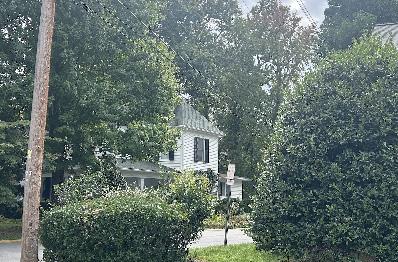
they were “so glad that [The Davidsonian is] looking into this, but as you say, it’s a difficult topic for me to talk about given my position at Davidson.”
Some new professors trying to navigate the process have given the school grace when it comes to their housing needs. Visiting Assistant Professor of English Maddie Norris currently resides in college housing. “The housing that I got is pretty affordable, especially for what the other options were,” she stated.
Yet, Visiting Assistant Professor of Drawing and Sculpture Luis Sahagun does not live in college housing. “[The college housing process] is purely driven on hierarchies—at Davidson, everywhere. So it’s no surprise to me, [as] somebody who has worked at different universities, to come to a place and be like, ‘Oh, you’re not going to get faculty housing.’”
Still, Sahagun believes Davidson is trying its best to be fair to the professors and faculty members. “I didn’t even fight it because [...] I’m a visiting professor,” he stated. “What I
really like is that they were upfront from the beginning, so they didn’t lie. They’re very transparent, which I respect.”
Sahagun believes the issue of professor housing at Davidson and other institutions is the product of a deeper issue within higher education.
“I love being here because I love teaching. I love students, [and they are] really wonderful to me in the art department,” he stated in his newly decorated office in the Visual Arts Center. “The housing thing is probably bigger than the [college], but I think at the end of the day, it just becomes more about people and the salary that they get, because the reason why faculty housing [even] exists is because the faculty can’t afford rent in the places where they’re teaching, and that becomes a fundamental issue all over. Shouldn’t you want your teachers to be in the same community as your students? [...] So there’s a bigger problem at play here that goes beyond just faculty housing. Faculty housing seems, at least, like an attempt to figure something out.”
JULIA RICHARDS ‘27 (SHE/HER) STAFF WRITER
CAMPBELL WALKER ‘25 (SHE/HER)
NEWS EDITOR
The Ada Jenkins Center, located about ten minutes from campus, is a community center where approximately eightyfour elementary students come after school to participate in learning enrichment activities.
However, this summer, Ada Jenkins made some changes to their programming. Zoë Clements ‘25 provided some insight into these changes. “Right before school started, we got a notice from the Ada Jenkins Center that they’re doing a new
submission [process] in order to be accepted as one of their enrichment programs.”
Clements, along with Isabelle Easter ‘25, are co-presidents of Ada Cooks, a club that focuses on teaching healthy cooking lessons. “The club was always oriented around teaching people how to cook nutritiously and in a way that was accessible,” Easter explained. Before COVID, Ada Cooks also hosted “longer cooking sessions with adults,” Easter added. Clubs must now apply for and be accepted into one of these programs in order to continue working with Ada Jenkins. Director of Education Services Leslie Wilson explains, “These enrichment activities are delivered through partnerships with organizations/groups selected via our Request for Proposal
(RFP) process, and students will participate in these regularly throughout the program year.” She continues, “we are collaborating with other organizations/groups outside the RFP process to offer special events and less frequent enrichment activities beyond the three key areas.”
Many after-school sessions at Ada Jenkins are run by Davidson clubs, and Ada Cooks was one of the clubs that was originally not accepted for after-school programming this year.
Over email, Wilson explained that new categories were created for the clubs. “Financial Literacy, Social Emotional
Learning, and Career Exploration are the three core enrichment areas we are focusing on to help meet our students’ needs,” Wilson stated.
“We applied for Social Emotional Learning, and I think that it was a combination of them not wanting as many clubs working for them, which might be speculation, [...] [coupled with] wanting to narrow it down, and we just didn’t fit in,” Easter stated.
In an email to the Ada Cooks Co-Presidents, Wilson stated, “We have selected another vendor whose solution best aligns with our current needs and strategic goals.”
STEM Enrichment is another club that was denied for afterschool programming. Sydney Ballard ‘25, co-president of STEM Enrichment, led biweekly lessons at the Ada Jenkins Center with her Co-President Aidan Dimitriou ‘25, their E-Board, and volunteers. “Our lesson plan tried to relate STEM to everyday parts of life, just to show young kids how science and math show up everywhere on an everyday basis. I think STEM can feel like a daunting field, so I would say our goal was just to show these experiments that would be really fun and engaging,” Ballard said.
Ballard explained a favorite activity among the students. “The kids always love when we do the Coke and Mentos bottle experiment. It’s fun to do a competition to see how high it [the Coke] goes. We’ve also done some very basic chemical reaction experiments that would make balloons blow up [...] Doing things that would be really engaging was the goal.”
Wilson began working at Ada Jenkins eighteen years ago, originally as the Enrichment Coordinator. She now works as the Director of Education Services. Wilson always enjoyed
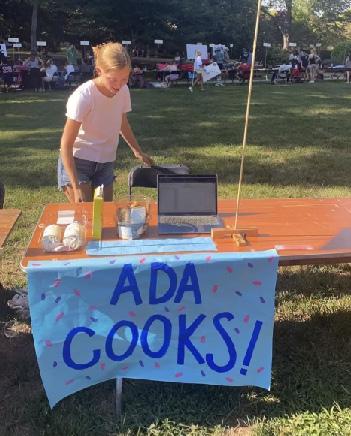
working in her community, especially with children. In an interview conducted over Zoom, she explained that before she started working at Ada Jenkins, she spent time “connecting with HOAs and schools and working and doing enrichment activities for kids.”
Wilson still loves what she does at the center. “It doesn’t
feel like work. I enjoy what I do each day. Working with kids each day is different.” She loves the community Ada Jenkins creates, explaining how the center creates an environment where the staff and community members are able to work together to create change.
Wilson recognizes the Davidson clubs that are no longer involved with the center. “They were long-standing clubs, and we appreciate their enrichment to help students discover interests and help apply reading skills or apply [other skills] to their lives,” Wilson said.
Despite the restructuring, Davidson students still have the opportunity to be involved with Ada Jenkins. “We have tutor mentors that we’re always looking for,” Wilson stated. There are some days that the new enrichment programs may not take place, so there are opportunities for clubs to fill these gaps and lead sessions. “So there’s still ways for student organizations to plug in that way,” Wilson adds.
Easter, Clements, and Ballard hope to continue working with kids in the community. “We’re definitely continuing the group,” Clements said. “We’re just going to change our name to Davidson Cooks so that it can be a little bit more allencompassing.” This way, they can continue their outreach at other locations or return to Ada Jenkins in the upcoming years. Clements hopes that no matter where they become involved, they will continue as a group that is “food-oriented and about food accessibility.”
Ballard is taking similar steps to continue working with STEM Enrichment in the community. “We’re trying to decide what makes the most sense for the values of our organization [...] we are really hoping to continue our work in the area because it’s something that we’ve all really loved.”
Amongst a plethora of student-run publications at Davidson, a yearbook to record student life and events has been missing from the college in recent years. However, Lanie DeMarcay ‘27 is currently tackling the challenge of leading a group of students to put out the first edition of Davidson’s yearbook, Quips and Cranks , since the pandemic in 2020.
First published in 1895, Quips and Cranks was an annual student-run yearbook, with occasional year-long gaps when national and international crises occurred. The gap from [the start of the pandemic] to now is the longest Davidson has gone without a publication. DeMarcay aims to lead the book’s comeback this year.
As a former editor of her high school yearbook, DeMarcay was disappointed to learn that Quips and Cranks had been inactive for years. “I was at the club fair looking for the sign-up. I [was] like, ‘Yes, I can’t wait to get involved,’ [only to] find out it does not, in fact, exist anymore,” DeMarcay said. However, DeMarcay’s curiosity lingered, and she reminisced about how she “dove into the history of [Quips and Cranks], spending hours on the archives website.” The value of having a record of the school year was emphasized in the recent absence of Quips and Cranks, DeMarcay argues. Still, she persisted, and she spent her first year at Davidson exploring the logistics of bringing the club back. “I spent all freshman year, any free time I had, making plans, systems, ideas, begging for more of a budget.” DeMarcay was finally able to get a budget, funding, and charter approved.
Due to DeMarcay’s self-driven hustle, Quips and Cranks is back for the 2024-2025 school year. Flyers have been displayed all around campus, advertising its weekly meetings, diverse range of tasks, and, of course, free food. “Our number one selling point is probably free food,” DeMarcay joked before delving into the actual reasons to join. “I think it is going to be the best way to get to know people on campus, to get involved and to try new things that might be out of your comfort zone, but making it fun,” DeMarcay elaborated.
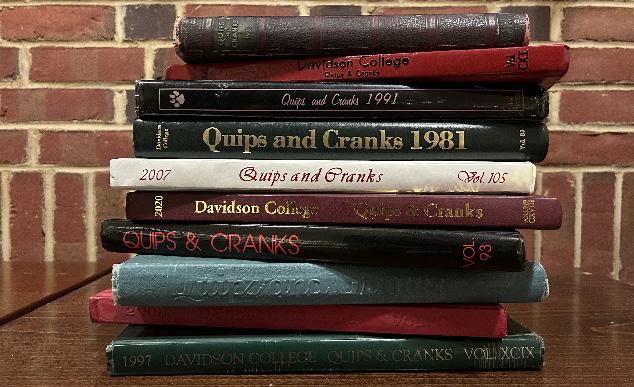
DeMarcay believes that the club has a unique opportunity to spread student perspectives on campus. “Essentially, you get to hide behind a camera, or get to talk to people and [...] learn about what they’re doing, so it’s just a great way to try something that might make you nervous, expand your horizons and get [you] to see all the parts of campus,” she elaborated. Students involved in the club are already praising DeMarcay’s leadership and the positive environment. Katlyn Salderini ‘27 was always interested in contributing to a yearbook but “never had the time” until now. Salderini does picture layout and page design for the yearbook. “[I’m] hoping to feel a rush of satisfaction after completing such a large project, and I’m hoping to feel proud of whatever I’m able to contribute to the yearbook,” she stated.
Another student, Noah Fisher ‘27, enjoys the process but is
focused on the end goal. “It’ll be interesting to see this all come together for the first time post-pandemic,” Fisher remarked.
When asked if it is too late to join, DeMarcay stresses that Quips and Cranks always welcomes new members. “It is never too late,” she stated. “You can get involved doing truly anything. You can just come to meetings and share your ideas.” There is always a need for new hands and faces. “We need people who are interested in photography, people who are interested in design, people who are interested in telling stories, people who are willing to do anything and everything,” DeMarcay emphasized. “We appreciate any and all hands we can get.”
Q: How are you feeling pre-debate?
A: I feel pretty good. I am going last, so I’ll have an idea of how the debate is going. I’m debating the North Carolina “Don’t Say Gay” bill from the Dem side, so that’s going to be really interesting trying to bring up some personal experiences and general concerns I have for the country going forward. I feel like we’ll be pretty prepared. Each person does not actually speak for too crazy long, and so we’re gonna try our best to be prepared for what we can and just be updated with the facts and the information and the figures.
Q: Do you have any rituals/ways to hype yourself up before you get going on the debate stage?
A: Well, we just met as a group, and we talked about going through each other’s points and intros and all that stuff. But in terms of rituals, no, unfortunately. The last time this was supposed to happen was 2020, so we don’t even have any rituals set up. I think because of that break, this will be the infrastructure going forward. I know I shouldn’t say this, but I can’t imagine 2028 being anything like 2024. I know I couldn’t imagine 2024 in my wildest dreams, and [yet] here we are. This is the third time Trump is running for office, [but] this is [an] opportunity [for the] first Indian, Asian American president, first female president possibly, and the second Black president to come to the United States.
Q: What is the format for the debate?
A: So if you come by the first twenty minutes, we’ll have a five to eight minute introduction by [President] Doug Hicks, and we’ll also have Sophia [Ludt], the president of CPE [Center for Political Engagement], come and open us up. I think maybe me and Stephen might introduce ourselves as the presidents of the Davidson Democrats and the Davidson Republicans to get us started. And also, people have the ability to take a pre-survey of the debate with QR codes, so that’s gonna be nice. We’re encouraging people to bring blankets if they want to lay down on the grass and just treat this as a community event, just because seating may be filled. So either that or get there early. But after that, we’re gonna have four different topics: economy, immigration, reproductive health, and the North Carolina “Don’t Say Gay” bill.
Q: What topic are you most looking forward to debating?
A: I’m really excited for the first one [the economy]. Actually, we’re opening for the first one. So the first person you’ll actually hear debate is going to be a Democrat. [...] So I’ll be happy to see him set the tone for the entire debate. And we’ll see. It’ll be weird because I’ll be the last one speaking and taking questions in that sense.
Q: What is your hope for the outcome of the debate?
A: So for each topic, there will be a winner and a loser, and it’s just about persuading people. I mean, I hope we persuade people. But I feel like Republicans aren’t just gonna, you know, walk into a wall, so I think our hope is to probably just win three out of the four topics; that would be pretty nice, because I feel like they’re definitely going to be prepared. So we’re just hoping that we can be
more prepared.
Q: How are you feeling about the state of the election overall?
A: I’m feeling optimistic, cautiously optimistic. I should say I’m ready to get the whole thing over with, but it’s still canvassing, still early voting, still getting everyone where they need to be. That’s where we are right now. But I’m cautiously optimistic. I’m fighting to make North Carolina blue. I feel really comfortable with Josh Stein right now. So it’s just the state house, trying to help Beth Helfrich, and then it’s Kamala Harris.
Q: If you were speaking with an undecided voter before election day, what would you tell them to try and advocate for the Democratic Party?
A: It would really depend on what their lifestyle is. Obviously different things matter for different people. I think my biggest thing would just be remembering what Trump focused on versus what Kamala Harris focused on. Donald Trump did not fix our border. He did not fix immigration. The biggest thing that he passed was a tax cut for the wealthy, when we already had the lowest inflation numbers and the highest GDP that we had in a while under Obama. And Kamala Harris passed the Inflation Reduction Act under Joe Biden. I think she was the tie breaking vote, and with that, people are now getting tax credits on their solar panels, on their EVs [environmental vehicles], and it’s just obvious who these people are prioritizing. Again, not everyone’s down for an electric car, not everyone’s down for solar panels, but we all have to agree that that’s clearly more emphasized for the middle class and what they’re trying to do with their homes and their vehicles, rather than what Donald Trump focused on.
Q: Aside from policy, what do you want students to get out of this debate?
A: I mean, one is just caring, just being aware of the things that are happening. I really hope that happens. And [I hope this happens] for the community as well, because there will be community members stopping by to hear the debate, I’ve heard. Other than that, I really hope we just get some interest. I know things kind of max out toward the election, but I hope people are watching and realizing that they have an impact on what’s going on. These numbers include them. They’re not just random things in the universe.
- Kailliou Macon-Goudeau On behalf of the Davidson College Democrats
Q: How are you feeling pre-debate?
A: We’ve just been researching, getting a good sense of the policies on our side, on the other side, and making sure we can make clear, concise comparisons and just give everyone a clear picture of their choices in this election.
Q: Do you have any rituals/ways to hype yourself up before you get going on the debate stage?
A: We probably should get one, but not right now. But I’ll work on that over the next few days, hopefully. Get some good luck going, some good juju going in.
Q: What is the format for the debate?
A: So Oliver Genovese from the freshman class will be debating economy for us. Alexa Cohen will be debating abortion for the sophomore class. Ian Anderson for the juniors will be debating immigration. And Monty Krakovitz, a senior, will be debating the Senate Bill 49, the parental Bill of Rights, or “Don’t Say Gay,” whatever you want to call it.
Q: What topic are you most looking forward to debating?
A: I think immigration is very pressing right now. It’s the crisis at the southern border, all the different national security risks that come with not being able to track who’s coming into the country. So that’s definitely what we’re all excited for, and to really get into the policy of it.
Q: What is your hope for the outcome of the debate?
A: I mean, I absolutely think it’s winnable. We have bright kids representing us. But also, a lot of the people are only looking to what Kamala Harris is saying, or what friendly media her campaign is saying, so definitely giving a more accurate look of what Republicans want to do on these four issues to people is probably the main goal. And just exposing people to our club, since, you know, [there is] not as much representation on campus.
Q: How are you feeling about the state of the election overall?
A: I’m pretty excited. I think there’s a lot of optimism, [...] there’s been a lot of great volunteering going on with people in our club, with the local party and local groups, knocking on doors, talking to voters, phone banking, all that sort of stuff. So there’s a lot of excitement, and we’ve all been working in different capacities to support the party all fall. So definitely looking forward to seeing all that work pay off, hopefully on November 5th.
Q: If you were speaking with an undecided voter before election day, what would you tell them to try and advocate for the Republican Party?
A: Well, look, four years ago COVID was a huge crisis. But when you look at inflation, the border, the state of foreign affairs, the economy, generally speaking, do you consider yourself better off than you were four years ago? I think we have a case that everyone was better off under Trump, and it’s because of the policies and a lot of the issues that we face as a country that [...] we believe stem from a departure from Trump era policies.
Q: Aside from policy, what do you want students to get out of this debate?
A: I definitely think the rhetoric and the deeper policy conversations don’t always line up, so being able to focus on policy and get people to look into it a bit closer than you normally can with social media is a big goal. But also, having people realize they don’t just have to follow the party that went before them. [...] People can help redefine the parties and lead the way and be influential voices going forward. So I think there’s not [many] better ways [than] in this debate to reflect that.
- Stephen Walker
On behalf of the Davidson College Republicans
Last month, I attended a North Mecklenburg Democrats meeting as part of a civic engagement requirement for my American Politics class with Dr. Crowder-Meyer. These assignments are meant to deepen students’ understanding of civics in a practical context that extends beyond the immediate Davidson College community.
I arrived at the Northern Regional Recreation Center, where the meeting was being held, and quickly took a seat toward the back of the crowded room. Scanning the room, I observed the demographic makeup—mostly white retirees. The agenda was projected on the board, someone’s grandmother had made brownies from scratch, and there was an array of pins and local candidate pamphlets strewn on the tables we surrounded—all things to be expected at this sort of meeting. What I did not expect, however, was the vocal cue that came next: to rise for the Pledge of Allegiance. There was a split second of fear that I wouldn’t be able to recite it properly. However, I stood up automatically and repeated the words in a sort of trance. I found myself unsettled, almost offended. Why was it that this moment, which should have been a simple expression of patriotism, felt so jarring? As I repeated the words, I felt strangely detached from their meaning, as if they no longer resonated with the values I once associated with them.
I left the meeting thinking about this feeling, and tried to identify when my views toward the practice changed. I didn’t go to an elementary, middle, or high school that had us recite the
Pledge of Allegiance in assemblies or before the morning bell, unlike many public schools in the United States do. I have vague memories of reciting it at large swim meets in middle school or the annual Fourth of July bike parade, but doing so was a rare occurrence in my life, so much so that the practice had almost entirely slipped away from my memory.
I realized, strikingly, that the practice has dissipated from society and communities that I identify with all together. This observation led me to ask an important question: if reciting the Pledge of Allegiance has become less common in certain circles, what does that say about our country’s relationship with patriotism? Has the meaning of this practice changed, or have we collectively distanced ourselves from it?
The answer, I believe, lies in the broader cultural and political shifts that have taken place over the past decade.
Since former president Donald Trump held office in 2016, I began to associate the American flag, the Pledge of Allegiance, and other aspects of American pride with his leadership and the sect of “Make America Great Again” (MAGA) ultra conservatives. An “Us versus Them” mentality has emerged: the former being a belief that traditional American values have been twisted by the far right to support bigoted leaders that deny groups of Americans basic human rights and the latter being that left extremists are anti-America and anti-God. Trump’s explicit use of the American flag, as well as red, white, and blue imagery, in merchandise and campaign ads makes these symbols feel less like a collective representation of national unity and more like a partisan statement. And while arguably undue, it is true
After hearing the story of Bill Edwards, a businessman, international spy, and fictional alumnus, to whom a book drop at the Davidson library was dedicated to, I stepped away from the table with a laugh. Beside me, an alumnus from the class of ’77 recounts playing in a brass ensemble in honor of Bill Edwards’s life. Mylar balloons proudly displayed the number fifty to passersby and a buttery popcorn smell permeated the air as a group of staff members threw a midday party commemorating the E.H. Little Library’s 50th anniversary.
Scattered about the tables were documents detailing the original floor plan (which included a smoking room), the rules of checkout, and the catering menu from the building’s grand opening. As I stood listening to the alumnus, someone who graduated exactly fifty years before I will, swap apocryphal tales with the library staff and the uproarious laughter his stories elicited, I was transported forward in time.
The older man was gone, and I stood in his place. Before me, I saw the expectant faces of a new cohort of Davidson students and staff. I wracked my brain for anecdotes concerning the library centennial. What would I tell them? I settled on something like this: it’s all too easy for me to recount stories of my time spent in the E.H. Little Library; my troubles lie instead in the perennially troublesome task of choosing which stories to tell.
The truth is, I fell in love with the library as soon as I arrived on campus. The stacks towered as silent as sentinels, promising shelter from the bustle of freshman orientation outside. The Davidsoniana Room offered me a glimpse into a past I hadn’t yet claimed as mine with piles of The Davidsonian articles written by alumni who had graduated decades before I
that many Americans share this sentiment and have begun to deny nationalism on the basis of it being tied to MAGA ideologies.
As a result, for someone like myself—someone passionate about public service, invested in the proper functioning of our government, yet increasingly alienated by the political climate—reciting the Pledge of Allegiance has become uncomfortable. To me, the recitation feels like a symbol claimed by a group that I fundamentally disagree with, especially as I see my rights and the rights of others being undermined by them. This dissonance isn’t necessarily about the Pledge of Allegiance itself, but about what it has come to represent in today’s America.
It is my sincere belief that this discomfort reflects a broader struggle with modern patriotism. How do we reclaim national symbols in a way that aligns with values of inclusion and justice? How can I, as someone who cares deeply about the future of this country, navigate the discomfort of nationalism without rejecting the ideals of civic duty and democratic engagement that I hold dear? These are questions I continue to grapple with.
Annalee Stuardi-Drumm is a Philosophy, Politics, and Economics (PPE) major from Philadelphia, Pennsylvania and can be reached for comment at anstuardidrumm@ davidson.edu
was born. Later in the year, once I had settled into Davidson, the tables gave my friends and I a space to work as we spent sleepless nights cackling—whether from sleep deprivation or genuine amusement, I’m not sure—in between study periods. As someone who spends the majority of their time in the library, I was, and to some extent still am, concerned about the upcoming renovations. I worry about the temporary closure of such a vital study space, about the accessibility of archival materials during the renovation, and about the availability of the services the library provides. Talks with Leland M. Park Director of the Davidson College Library Lisa Forrest have begun to alleviate these fears of mine, mostly arising from the uncertainty of how life in the interim will proceed. I felt relieved to hear her explanation of the interim library plans.
But most of all, I worry that the new library will be fundamentally different from the one I fell in love with and that students after me won’t have the same experience I did. Maybe that’s good—the new library will be more accessible, more inviting, and more inclusive of different study styles. On the other hand, after sitting in on a renovation focus group meeting, I believe there’s a crisis of identity among students as to what a library should be. So, in light of the focus groups and planning committees soliciting student input, in light of public libraries across the country fighting against budget cuts and book bans, I’ve attempted to articulate (in an awkward rambling declaration of my feelings) why I fell in love with the E.H. Little Library. To me, she’s a sanctuary, a refuge from the whirlwind of activity at Davidson. She’s a place to briefly disconnect myself from the outside world and focus almost exclusively on academic or intellectual pursuits—with the occasional interruption from friends! When I walk through her doors, I embrace the classical liberal arts idea of college in which a student stands apart from the forces of the world, sequestered away to study. When I leave, I choose to embody the modern ideal of a col-
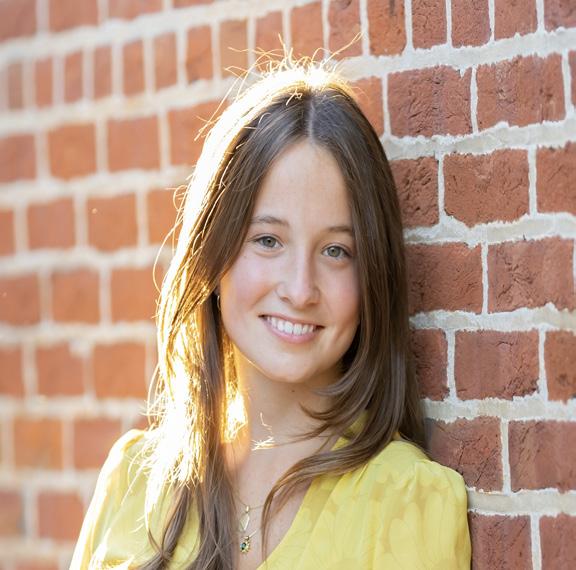
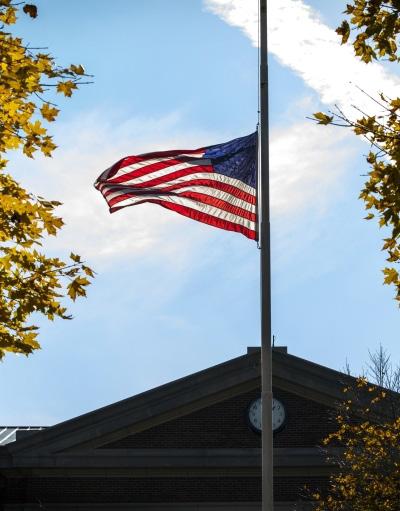
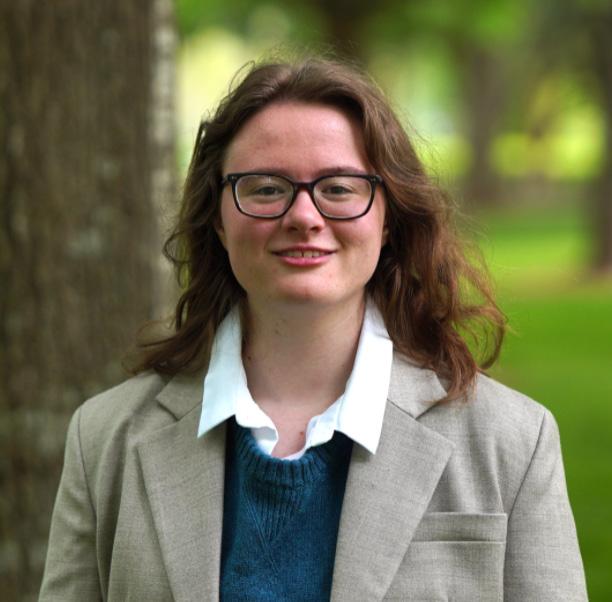
lege student: one that is actively engaged in social, political, and cultural efforts spanning far beyond the borders of the college community. I believe there should be space for both on a campus, but the library has traditionally been a space for quiet contemplation.
She’s also a guardian of those who have seen their identities become increasingly politicized, anathema to the forces pushing book bans in public libraries. She provides a space for everyone to see their identity reflected upon the page, some for the first time. As a place, she disconnects mere being from politics, while some of the materials within emphasize our constantly politicized identities and our unseverable bond with the forces at work shaping our identities. I think the current library does a good job of striking this balance, simultaneously apolitical and contentious. While she provides a space for students with marginalized identities to simply exist without their right to exist being debated, she also promotes materials that facilitate a deeper understanding of and engagement with these identities.
Abby Smetana is an Undecided major from Raleigh, NC and can be reached for comment at absmetana@davidson.edu
Correction from “Chick-fil-A Owners Continue to Donate Millions to Discriminatory Groups. So Why Do We Want One on Campus” in our 10/9/24 Issue: Davidson is a Chickfil-A licensee, not a Chick-fil-A franchisee.
ANNA MORROW ‘28 (SHE/HER) SPORTS WRITER
Scott Abell, head coach of the Davidson football team, celebrated his 45th career win on Saturday, October 5th, in a 42-19 win over Marist College on Field 76. This milestone win put Abell at the top of the list for career wins, breaking former Head Coach William Younger’s record that stood from 1931-2024.
Coach Abell started his tenure as head coach at Davidson in 2018 after a successful career as offensive coordinator and head coach at Washington and Lee University (W&L) in Lexington, VA. Many of his staff members at W&L followed him to Davidson, and he attributes much of his success to them. One of the coaches who joined Davidson from Abell’s staff at W&L is Offensive Run Game Coordinator and Offensive Line Coach Vince Munch. “[Abell’s] an incredible leader and always finds a way to win, and it was just a blessing to be part of this milestone. I’ve been here for all of those wins, so to see number one to number forty-five was awesome,” Munch stated. From W&L, Coach Abell not only brought along a group of talented coaches, but also a uniting motto: WE. “Win everything, win everywhere, with everyone. I think that encompasses everything we want. We want to be the best version of ourselves and try to perform at a high level, [...] whether we’re in the classroom or on the field,” Abell explained.
Coach Abell’s success as a coach, on and off the field, is evident when speaking with his players. Andrew Frazier ‘27, Davidson’s current starting quarterback, said that “Coach Abell is one of those people at the top of the list that’s helped me with my growth, especially at quarterback. [He] is just such a phenomenal coach, and I’m blessed to say that, yes,
Coach Abell is my coach.”
Coach Abell has high praise for the sophomore quarterback. “He [Frazier] had a decorated high school career as a quarterback.” But Frazier entered a full quarterback room at Davidson, “so he spent the spring learning slot, and he earned a starting job,” Abell said. However, injuries to Davidson’s two key quarterbacks, Luke Durkin ‘25 and Coulter Cleland ‘26, created a need for a new starter. “He [Frazier] picked up right where he left off. It really looked like he hadn’t missed a day and took and ran with it. That’s not easy man,” Abell elaborated. “People see our quarterback world, and I don’t think there’s many programs that would have survived playing as many quarterbacks as we did. [...] They help each other. They coach each other.”
Davidson’s run-heavy offense makes the quarterback changes easier to manage, with starting running back Mari Adams ‘27 leading the backfield. So far in the 2024 season, Adams has rushed for 749 of Davidson’s 2,103 total rushing yards. The Wildcats have led the NCAA Division I Football Championship Subdivision (FCS) in rushing yards for four straight years and possess the number one FCS scoring offense in 2024 with 40.0 points per game. As one of Coach Abell’s leaders and offensive playmakers, Adams spoke to Coach Abell’s accomplishments. “He’s a great coach, a very hard worker, and only wants the best for us. [But] just as much as that, [he’s] a great person. He [has] instilled in us all the things that we need. I’m glad he gave me a chance to play for him.”
This year, Coach Abell had his third ever Davidson player chosen for the Allstate American Football Coaches Association Good Works Team: senior defensive end Julian Rawlins ‘25. Rawlins is among twenty-two college football players from across the NCAA who have been chosen for the outstanding impact they have had on their community. “It gets
Oback to our motto, WE. If we’re really going to represent that, then we have to be willing to be servants [to the community],” Abell said. And even though Coach Abell hopes for playoff success in November, he constantly looks back on all of the Davidson players who serve their community. “I’m as proud of that as I am of winning championships.”
COLIN DECKER ‘27 (HE/HIM) SPORTS WRITER
n Saturday, October 5th, the Davidson volleyball team toppled the visiting George Mason Patriots three sets to two. With the win, they split the series with George Mason and improved to 6-9 on the season. For Head Coach Chris Willis and his players though, wins and losses are the last thing on their minds.
“Our team has been very resilient. That’s the biggest theme that I’ve taken away so far. When somebody’s been injured or couldn’t play, [the] next person stepped up and played really well. When we’ve lost a match, I never felt like we gave up,” Coach Willis said ahead of their October 8th matchup with VCU.
Coach Willis and his team champion the idea of mental preparation. They place tremendous emphasis on “being in the moment” and “mindfulness.” “Playing our best volleyball on the next point is our goal, every day,” said Willis. For senior Kayla Davis ‘25, who has been injured this season, the “be in the moment” mentality takes on a special meaning.
“‘Be in the moment’ hits a little bit differently as a senior. This is not only my last opportunity to have experiences as a DI volleyball player, but these are the last opportunities I have with my teammates. So yes, ‘be in the moment,’ be thankful for everything, are all things that have been huge for me this season. Even now with my injury, I may not be playing, but I still get the opportunity to be with my teammates each day,” said Davis.
Despite rallying back to play competitive sets, the Wildcats dropped their match against VCU 3-0. Undeterred, Isabel Decker ‘25 was able to find the positives from the match and stick to the mental process. Decker provided a player’s
perspective on the team mentality: “This year we’re really not focused on the outcome of the matches for our record, just really focused on growth and supporting one another. Also, having that [competitive] fire throughout the entire set is something that we’ve been trying to work towards.” Decker noted that another positive was the amount of freshmen that have been getting meaningful opportunities on the court. “We’ve been very proud about how they’ve [the freshmen] have been playing [...] [they’re] giving it their all no matter what.”
On Saturday, October 12th, the team fell to the George Washington Revolutionaries 3-0 in their first game of a doubleheader. Coach Willis did not let a disappointing outcome distract from the growth of his players on the court and pointed out several positives from the match.
“I was proud of how we bounced back after a lopsided outcome in the first set; we battled the entire match. I’ve also seen growth in our mental game. Our team is very resilient. We’ve had some setbacks this fall, and [the team continues] to respond in the best manner,” Willis reflected.
The ‘Cats got back on track the next night against George Washington, overcoming a two set deficit to take the match 3-2. Coach Willis described a moment from the end of the third set that turned the tide in the team’s favor: “We had a five minute break and met as a team to talk about a few adjustments. I allowed each position group to talk about what they wanted to improve on in the next set. Each group got about twenty seconds to address the team and be accountable for their contribution. It was then great to see those words play out on the court. Our offensive numbers soared and [our] defensive effort was what we needed to stifle [George Washington]. Overall, it was a moment of clarity that we hadn’t played our best and if we could focus on purpose driven execution, we would have a chance to win.”
It was a career match for Decker, who recorded her 1,000th kill of her Davidson volleyball tenure. “We are all proud of how hard we fought to get the reverse sweep this weekend. It took every person being 100% committed and believing that we could win. I think we can use this weekend as motivation that when we are 100% determined, we can beat any team,” said Decker.
That world-beater sentiment is echoed by Coach Willis, who–while staying in the moment, of course–has his eyes ahead to the postseason. “My takeaway is that when we play to our potential, we are one of the top teams in the conference. Through our injuries, the first-year players have earned valuable playing experience, which gives us quality depth on our team. One of our goals is to be healthy and productive by November to make a run in the postseason. We’re slowly getting there.” The ‘Cats are currently 7-11 and play away at Saint Louis this Friday, October 18th.
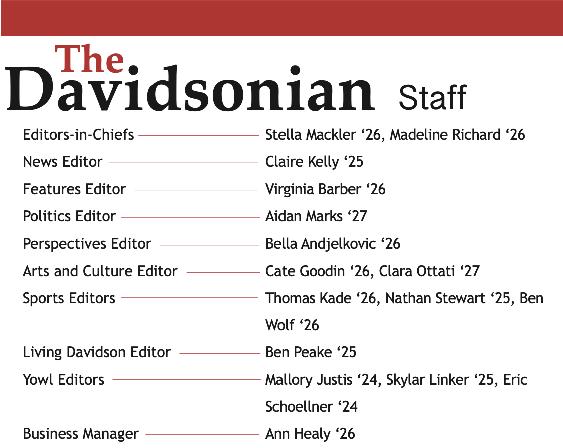
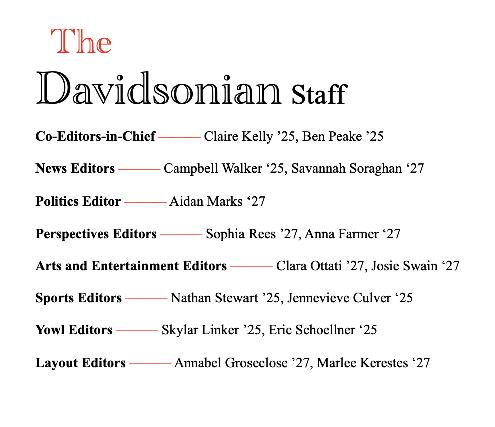
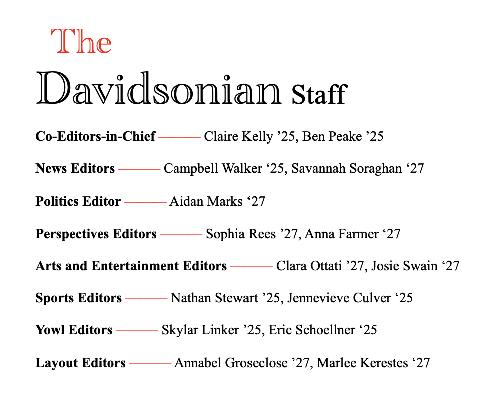
North Carolina artists.
On the first Friday of October, Davidson students interested in the arts loaded onto a bus and drove into Charlotte for an art museum crawl. The Davidson College Art Department organized the “Art Crawl,” a visit to multiple galleries and museums all within walking distance, and offered tickets free of charge to all students who attended.
The first stop was the Harvey B. Gantt Center for African-American Arts + Culture. The museum, named after Harvey Gantt, Charlotte’s first African-American mayor, contains works celebrating African-American culture and community. The architecture of the building is striking and purposeful, from the exterior pattern reminiscent of quilts from the Underground Railroad to the prominent staircase, a biblical reference to Jacob’s Ladder. The works in the Gantt Center vary from modern abstraction to videography to portraiture from local
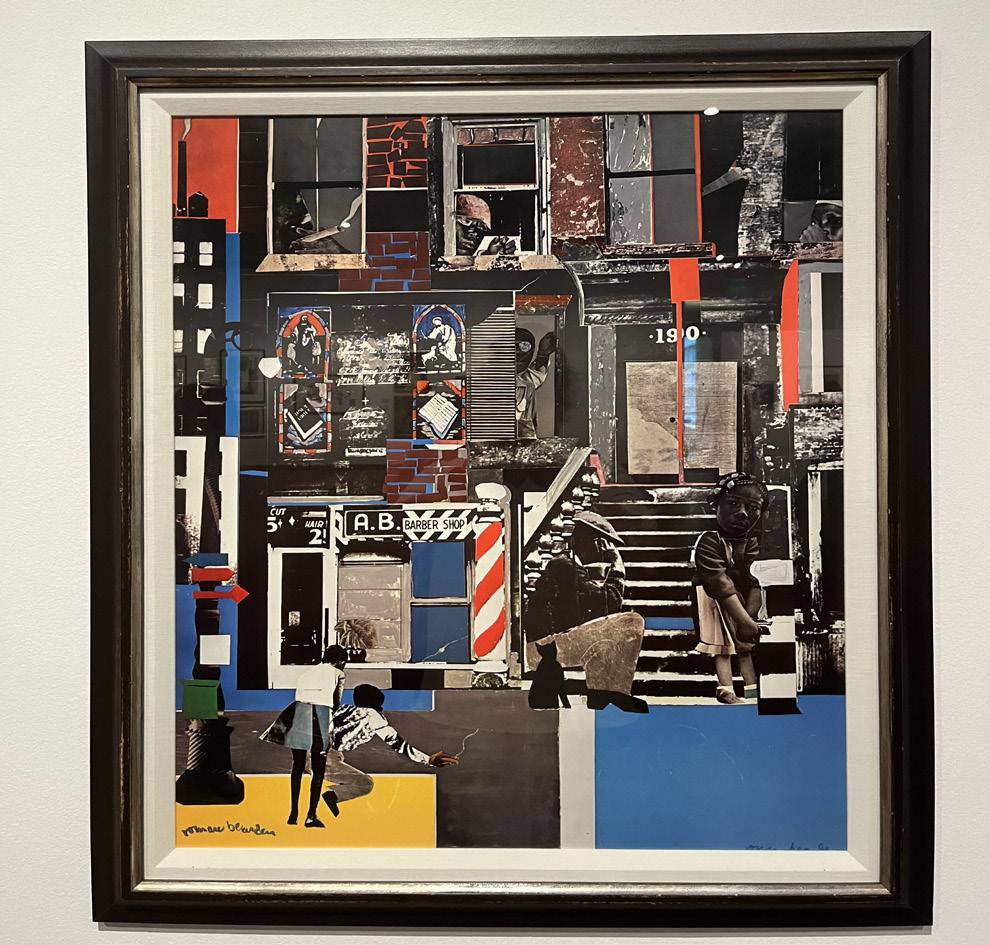
Sami Shimpi ‘27, a double major in Art History and Environmental Studies, shared that the Gantt Center was her favorite part of the Art Crawl due to her deep interest in Latinx and African-American art. “Being in Postmodern Art in the U.S. with Dr. Corso-Esquivel helped me contextualize the artwork within a postmodern framework. I was able to recognize various styles and the significant use of identity politics in these exhibits,” Shimpi noted. “My favorite piece from the crawl was a collage [Harlem Street Scene] by Romare Bearden.”
Mint Museum Uptown was the next stop, which contains craft and design collections and renowned American contemporary art collections. A highlight of the museum was the collection of works by Beauford Delaney, an American modernist painter. Bella Rosenfeld ‘27 felt inspired upon seeing the piece by Delaney, an artist with whom she is very familiar. Rosenfeld is no stranger to the Mint Museum, and had ventured over with another Davidson group in the past. “My first visit was last year with my Humanities class,” she explained. “Since then, I’ve taken an art history course at Davidson. This second trip to the Mint heightened my appreciation of the art.”
Rosenfeld also enjoyed taking in the surrealist artwork that was on display at the Mint. “I was most excited to see an oil painting by Gordon Onslaw Ford, it’s called The Love Knot.” Rosenfeld also mentioned a sculpture by Cristina Cordova, titled Preludios y Partidas, that surprised her. “I haven’t been into sculpture in the past, but for whatever reason, I found myself just staring at this one piece. It was so cool. I guess that’s the great thing about art crawls: you’re bound to find something new!”
The group of crawl attendees made their final stop at the Bechtler Museum of Modern Art. The museum’s plaza features a striking sculpture: a mirror mosaic titled Firebird. At seventeen feet tall, the sculpture is impossible to miss and offers an exciting welcome to visitors.
The first exhibit on view included a variety of works by artist Clare Rojas. Rojas explores themes of ecofeminism and music in her work, which ranges from large-scale paintings to bronze sculptures. One bronze piece that was highlighted was titled Emmanuelle (The Lord is Among Us). The sculpture depicts a flower pot with a singular calla lily flower, and within the center lies a human-like face. This work serves as a representation of the interconnectedness between women and nature. Because these pieces were made by the same creator and followed the same thematic narrative, the gallery’s flow felt different compared to those at the Mint and Gantt Center.
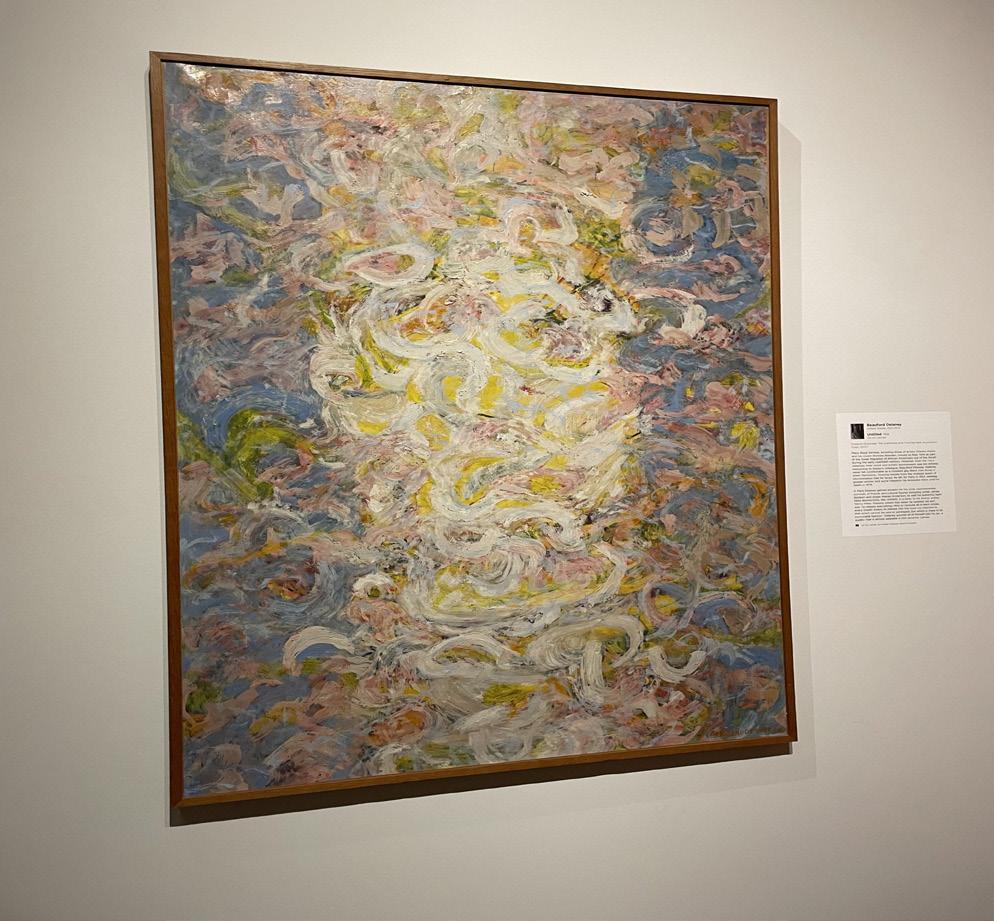
The second exhibit at the Bechtler explored surrealism, celebrating the 100th anniversary of the surrealist movement. The exhibit’s title, Chance Encounters: Surrealism Then and Now, alludes to the exhibit’s unique curation, which includes both historical surrealist artworks and contemporary pieces following the surrealist movement. In tandem, these two styles of surrealism offer a nuanced perspective of the progression of the movement. “As the viewer, I enjoyed comparing and contrasting the different pairs,” said Shimpi. Finny Roach ‘27 appreciated the exhibit and crawl: “It was an amazing chance to be exposed to art I wouldn’t normally go out of my way to see.”
Victoria Spadacenta ‘27 is an Art History major from Durham, NC and can be reached for comment at vispadacenta@davidson.edu.
The Nancy K. Smith Artist Series Committee of Union Board, whose members provide students the opportunity to enjoy professional talent on campus at least once per semester, organized the event, with member Vimi Wang ‘27 playing a key role in the process.
On Friday, October 4th, The Second City improv troupe, a comedy group from Chicago, Illinois, performed for a crowd of Davidson students and community members in the Duke Family Performance Hall. The group is renowned for its star-studded list of alumni, including Tina Fey, Jordan Peele, Mike Myers, Steve Carrell, Stephen Colbert, and Amy Poehler. This year marks the 65th anniversary of the founding of the company and its contributions to the world of comedic theater. The Second City is the longest running improvisational theater in Chicago and the acting troupe has expanded to both Toronto and New York.
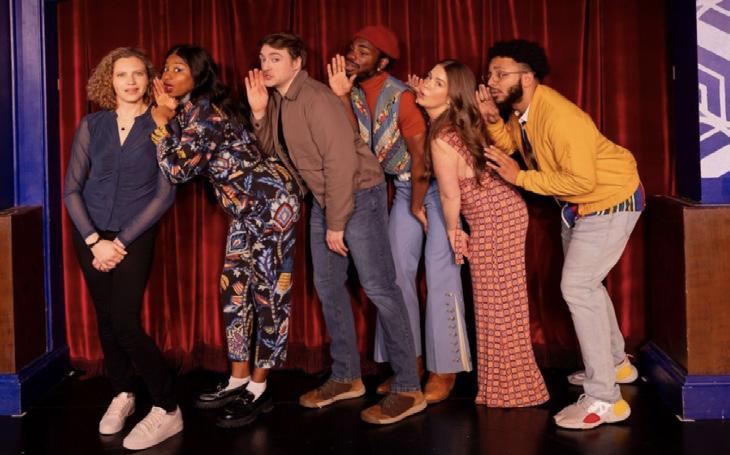
“I think it’s always refreshing to see what the professional world looks like, and [we love] to have groups who are already in the comedy or dancing or performance industry come and inspire students,” Wang explained.
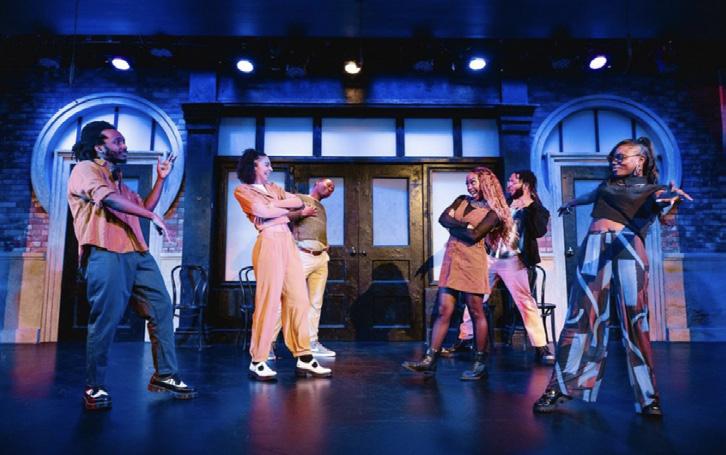
Despite the difficulties of planning out largescale events like these for students, Wang says that she still enjoys the benefits of being part of the Smith Artist Series. “I think it’s really nice to [...] have some control [over what] students want to see. It’s definitely an eyeopening experience for me, to see how much work goes into making this happen,” she shared.
The show included audience interactions to inspire various sketches. The improv group used various sketch formats, starting with a variety of previously rehearsed, short, fast-
paced skits.
Audience member Rose Cecchi ‘27 thought that the speedy nature of the show added to the quality. “I thought the show was very wellpaced and I think that helped engage audience members. I don’t really have any experience with improv and so getting to see The Second City live was definitely a great introduction,” she said.
“My favorite part of the show was a skit that had two of the actors pretending to be spies. They played a word association game in trench coats. It was unexpected and definitely got a lot of laughs out of the audience,” said Ben Peake ‘25.
The crowd brainstormed wacky prompts for the actors, starting with a couple co-parenting
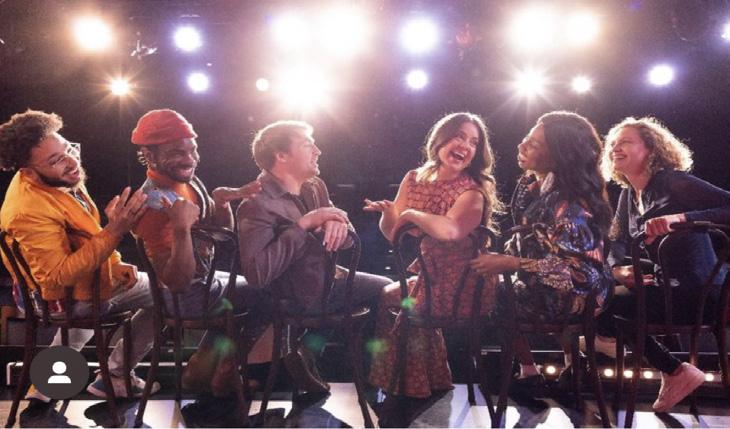
a one-eyed cat, which then transitioned into the couple making pasta together. This section was Cecchi’s personal favorite. “I thought all the actors were so creative, and each sketch went in directions that you didn’t expect,” she explained.
Additionally, the actors created a song from audience-suggested lyrics, featuring all
members of The Second City improvising rhymes and lyrics that corresponded to the original audience suggestion: stepping in dog poop. Wang enjoyed this part of the performance the most. “I loved when the [actor] asked the audience for suggestions. I was so impressed by the song. How do you just [improvise] a whole song?”
The show finished with all the actors from each sketch returning and replaying their sketches in reverse order, pulling off one more bit for the audience. Whether in Chicago or here at Davidson, it’s clear that The Second City is beloved by actors and theater newbies alike.
Harris Huber ‘27 is a History major from New Orleans, LA and can be reached for comment at sthuber@davidson.edu.
Bryn ___ (Pennsylvania college)
2 Skin-cream element
3 Twix candy maker
4 “No questions ___”
5 “Keep cool!”
6 Assn. or grp.
7 Ben Baker’s dept.
8 Cup carrier
9 19th-century fur trade monopolist
10 Casino bigwig
11 Bottom 33.33%
12 Residential property ___ (space available for lease to students)
13 Le ___
18 A part of
24 “... having ___ makes you rich”: Louis Sabin
26 Bring in, as a crop
27 Certain choir members
28 “Grand” instrument
29 The River Styx is one of its boundaries
31 ___ water (facing trouble)
33 Appropriate for Halloween
34 Diuretic’s target
37 Barney Fife portrayer
39 Be told
40 “Terrible ___” (toddler’s phase)
43 Belk Hall has five
47 Continuing tale
48 Accrue, as interest
51 Cynthia feature?
53 Couples
54 Ajar, say
55 1998 Daytona 500 winner Earnhardt
57 Ancient strongbox
59 Oxfam and Mercy Corps, e.g., in brief
Word that may follow the first and second words in 17-, 39-, & 63-Across and 11- & 29-Down 70 See 21-Across
60 Criminal
61 Marginal “leave it”
64 Sib of a bro
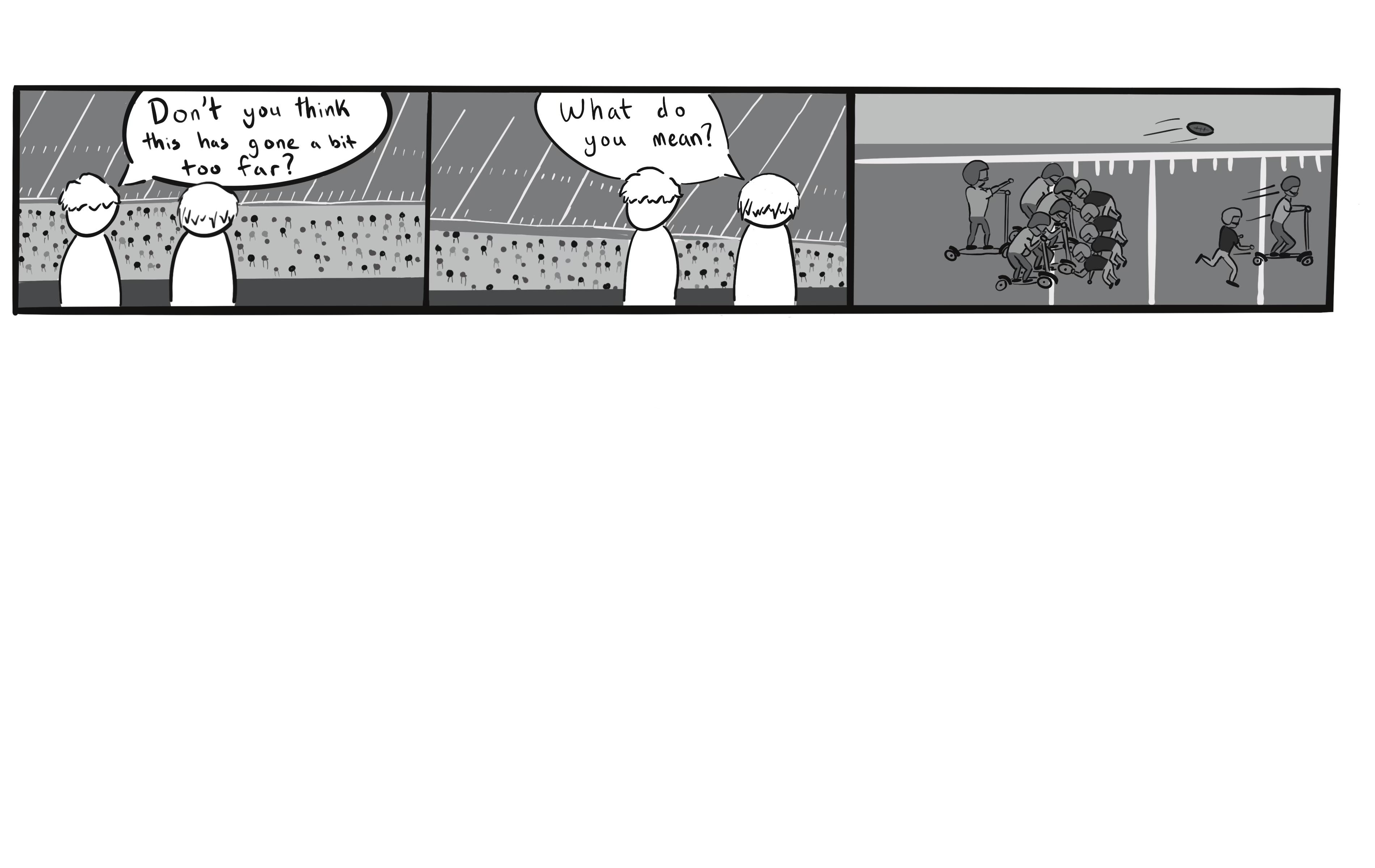
Time Reported Description/Location
10/12/24, 01:15 hrs
students were able to ask a variety of questions concerning issues like the Honor Code,
Met with Dining and Auxiliary Services and overviewed the plans for the construction of Chick-fil-A. Explored the potential to shift the 2025 meal plan back to dining dollars
Airport shuttles ran successfully. Working on ways to streamline the waiver and sign-up
Started planning a community responsibility event with the Food and Housing CommitConnor Hines and SGA Vice President Maya Rajeh will be able to update the trustees on the student body at the Campus Life and Student Experience Committee. Hines will also speak to all of the trustees during Friday’s plenary session.
FHow to Get a Relationship in Time for Cuffing Season
Page IDK
yowl.com/autumnalvibes The Fiend Issue
It’s the Middle of the Semester! Pick Two: Showered Recently, Well-Rested, Food Secure Page B.O.
October 16, 2024
Nummit Barista Requirements Revealed: Nose Ring, Tattoo, Overwhelming Need to be Cool Page Manic Pixie
Thought You Had a Cool Fall Break? Here’s Eight People Who Did More Eventful Things Page Literally Everyone
or the past few years, a groundhog has found a home behind Qdoba. In the past, if you were lucky, you could spot this rodent right around dusk hiding in storm drains, but lately this little critter has grown more confident around the student body.
Girl Uses Entire Meal Swipe on Singular Drink at Nummit—Still Has to Pay Remainder Page Fiscal Freak
Fall is in the Air! So Are These Twelve Different Diseases Going Around Campus Page Plague
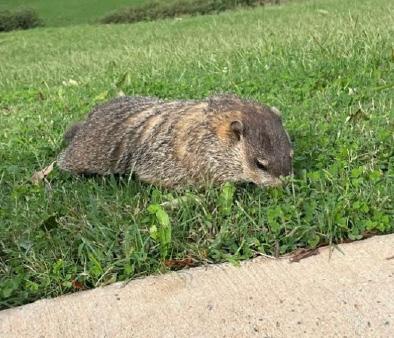
Wit the groundhog’s burgeoning comfort came concern from the public. In a private forum for the Davidson chapter of the Secret Collective of Animal Taming (SCAT for short), one member, who I cannot name for privacy reasons but remained unbiased and I swear isn’t me, expressed his worry over the creature’s rabies status, continuing to hypothesize that the groundhog’s confidence around humans is an effect of delirium brought on by the rabies. Another member brought up the meteorological consequences of groundhog intervention. In popular culture, Americans celebrate an annual occurrence described as “Groundhog Day.” In this ceremony, a divinely blessed groundhog, Punxsutawney Phil, decides the fate of the seasons. Projected to every phone and television, his decision is recorded for further analysis, as researchers are still unsure of the divine properties of Punxsutawney Phil. During the process of his decision, Phil is presented with this year’s offerings. If the collection is found to his liking, Punxsutawney Phil egresses from his dwelling and calls upon the sun to melt off the decay of winter. However, if Phil finds the offerings unsatisfactory, he will retreat into his burrow until he sees fit.
This traditional practice is concerning for the community in light of this campus groundhog. Users on platform Yik Yak have dubbed the groundhog “Little Freak” in an attempt to embarrass the creature in order to deter psionic attacks.
This is more than just a worry for some students. In a SCAT meeting, student Jortan Jangle presented their
groundhog research findings. Jangle explained that groundhogs like Little Freak and Punxsutawney Phil have innate supernatural abilities, allowing them to alter geomagnetic and meteorological states. Jangle went on to add that Little Freak may actually be even more powerful and dangerous than Punxsutawney Phil due to Little Freak’s enchanted tooth. This tooth may allow Little Freak to harbor further, darker magic that normally would corrupt a lesser rodent. In Figure 1.2 below, you can see the sheer power of his particularly long tooth. Another concern over Little Freak’s presence is his uncertain preferences for offerings. As Little Freak begins to appear more on campus, we must begin to take note of the implanted messages he sends to our minds and establish a set offering in order to soothe Little Freak’s psyche. Ultimately, Davidson students must remain aware of Little Freak, who has been largely overlooked as a threat to humanity. But now, I must ask you, how long will it be until Little Freak takes a human life as an offering?
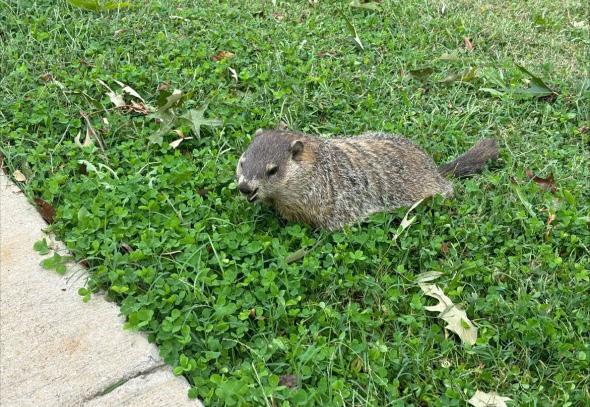
The vaunted Davidson social scene has one of its major events occurring this Friday night: watching two sets of the most obnoxious people on campus shout at each other between two buildings. Nothing gets Davidson students excited for a rowdy night out on the town like hearing other students relitigate political platforms you’ve already made up your mind about. What could be a better use of your Friday night than having a political science student humanities-splain an election to you that has had the same major candidates from primaries four years ago? What do you mean you don’t want to sit in the middle section of this campus and hear from the human embodiments of the debate columns that have run in this newspaper three times? Worry not! You can pregame this event with a $25 Jalapeño Cider pitcher. No one wants to talk about the damage that the Beer Czar has done to this fine institution at Nummit. After choosing between your options of drinking the worst IPA you’ve ever tasted or basically apple juice, you can wander over with a gaggle of social justice Instagram warriors to witness the debate. Heckling is not only tolerated, but encouraged. We as a society need to normalize booing your classmates when they make a bad point, and this is the perfect opportunity to throw the first rotten tomato at Eu Hall. Hearing a less coherent and less interesting recap of points made on the national stage sounds like the best use of your Friday night! It’s just like hearing from your local politician, except it’s your classmate and they don’t have any power or leverage to change the situation, and they have the exact same sources and information as you do. Given that I have received no less than four emails desperately asking for someone—anyone—to sign up to debate in just the last week, it’s fair to assume our debaters are fired up for this weekend as well. The master debaters are going to make a real show of it for you. Nothing beats a Davidson Friday night hearing debates on points you have already staked a personal position on. While this sounds critical of the debate, we wholeheartedly believe that this is still more fun and a better use of your time than going to F.
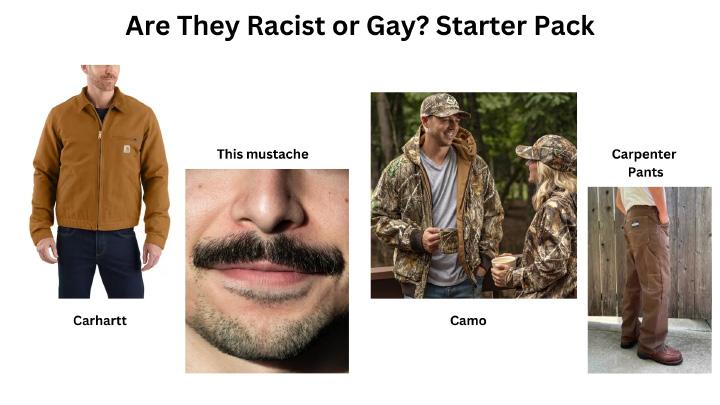
WRITERS Cordelia Stamps The Editors - pls send us stuff!!!
Your Classmates Debate on a Friday Night? All Time Low QUOTE OF THE WEEK
“You don’t use a loofah or a brush or a washcloth to wash yourself. You just use your hands, and you are dirty.”
- Girl Talking to her Boyfriend
•
• Math: The Quadratic Formula
• Poli Sci: Ronald Reagan’s Face
• Dance: Flamenco Dancer Emoji
Note: The Yowl is a satirical supplement to The Davidsonian Hence, nothing in it should be taken as truth.